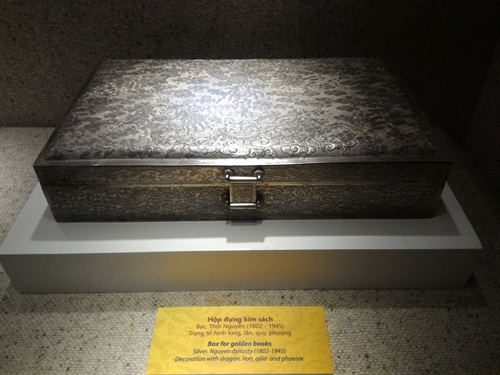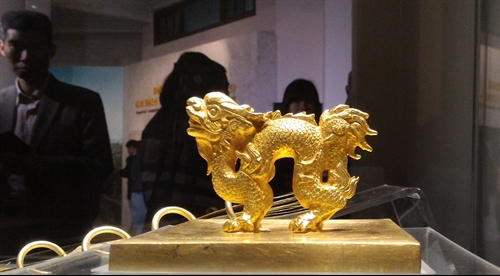 Life & Style
Life & Style

The gold books of the Nguyễn Dynasty are on display at the Việt Nam National Museum of History. They record important events of the Nguyễn Dynasty state affairs and imperial ceremonies such as emperors acceding the throne, the crowning of princes and queens, and the recording of the inauguration of imperial titles to members of the royal family.
 |
| Mysterious: An elegantly carved silver box is part of the display. |
HÀ NỘI – Following the will of Emperor Tự Đức, Emperor Hàm Nghi in 1889 inaugurated his grandmother Từ Dụ (or Từ Dũ) as Queen Grandmother. The gold book and seal marking this event are now on display at the National Museum of History.
Entitled “Imperial Treasures – Gold Books of the Nguyễn Dynasty (1802-1945),” the exhibition for the first time puts on display 22 gold books, 10 gold stamps and other precious imperial objects.
It provides the public with an insight into the significance of these treasures as well as an historical, cultural and aesthetic appreciation of the Nguyễn Dynasty, according to Nguyễn Quốc Hữu, an official from the museum.
Từ Dụ (1810-1902), whose real name was Phạm Thị Hằng, was Emperor Thiệu Trị’s wife and Emperor Tự Đức’s mother. The woman whose name was given to a contemporary hospital in HCM City was famous in Vietnamese history for her tolerance and benevolence.
She was the first and only person conferred with the title of Queen Grandmother during the Nguyễn Dynasty. When she was young, she was gentle, virtuous and good at educating her children.
The book includes seven sheets. Both covers were decorated with dragon and cloud patterns, and the content praising the Queen Grandmother appears on the five sheets inside.
The gold books of the Nguyễn Dynasty are special ancient manuscripts made of precious materials. They were carved with five-claw dragon, phoenix, cloud and flower patterns. Many books come with seals carved in honour of the individuals they were made for, such as queens and princes.
They record important events of the Nguyễn Dynasty state affairs and imperial ceremonies, such as emperors acceding the throne, the crowning of princes and queens, and the recording of the inauguration of imperial titles to members of the royal family.
The golden books were compiled by emperors or high ranking mandarins. They were manufactured by book makers in the Ministry of Rituals.
The collection of gold books are stored at the Việt Nam National Museum of History. Before, they were preserved at the Việt Nam State Bank because they are so precious and no museum had a suitable environment to protect them.
“Each of them contain valuable information about imperial history, morality, official regulations and ceremonies,” Hữu said. “The information portrays the lives and careers of the emperors and also of other high ranking officials.”
Officers at the museum have spent much time researching the historical books to discover the context and events taking place during the Nguyễn Dynasty so that they can understand the contents of the books and why they were carved.
“During the research process, we realised that Nguyễn Kings paid gratitude to their ancestors. They expressed their filial respect to parents and grandparents and praised their moral values.”
Almuth Meyer-Zollitsch, director of the Hà Nội Goethe Institute, was one among first visitors to the exhibition. She couldn’t hide her admiration for the craftsmen who created the golden books. “They’re high-ranking artisans,” she said.
“It’s a very impressive exhibition because for the first time, these precious books are being shown to the public,” she said. “They show the history, heritage and flourishing art of Việt Nam under the Nguyễn Dynasty.”
She expected that in the near future, researchers will be able to translate the content of the books, written in Han scripts, to Vietnamese and other languages so that people can understand what the book says.
“The museum staff presented this exhibition in the clearest way so as to introduce and explain the historical context of the artifacts in both Vietnamese and English. However, I’m curious to know each word in the book.”
The exhibition will run until the end of July at the Việt Nam National Museum of History, 1 Phạm Ngũ Lão Street, Hà Nội. -- VNS
 |
| First sight: Entitled “Imperial Treasures – Gold Books of the Nguyễn Dynasty (1802-1945),” the exhibition shows 22 gold books for the first time. VNS Photos Minh Thu |
 |
| Royal: Many books come with seals carved in honour of individuals such as queens and princes. |
 |
| Roaring success: A gold stamp bears the shape of a mythical lion. |




